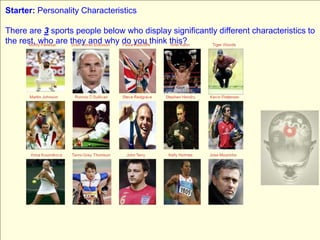
PEShare.co.uk Shared Resource
- 1. Starter: Personality Characteristics There are 3 sports people below who display significantly different characteristics to the rest, who are they and why do you think this?
- 2. If you identified the 3 below as sports people who all display less ambition, less competitiveness, a lower need for control or a slower work rate, the well done! What else did you come up with? Like Sven, Stephen is a thinker and is reserved in his approach in comparison with Ronnie O’Sullivan. Kournikova appears to be less competitive as she concentrates on commercial modelling rather than tennis. Sven is more of a strategist, taking his time to work through things. As a result he works more slowly and is less prone to stress.
- 3. Having a positive attitude is essential for success. By the end of this week you should be able to: ·explain what is meant by the term 'attitude' ·describe the components of an attitude ·outline the factors influencing the formation of attitude and how they influence behaviour ·understand the importance of developing positive attitudes towards specific attitude objects and the impact a negative attitude can have on performance ·describe the methods used to assess attitudes and evaluate their effectiveness ·explain the methods used to change an attitude including cognitive dissonance and persuasive communication
- 4. Attitude With a partner come up with your own definition of 'attitude' and attempt to describe characteristics of your own attitude
- 5. ATTITUDES – A learned behavioural predisposition. (linked with personality)
- 6. Definitions Aronson et al (1994): 'An enduring evaluation - positive or negative - of people, objects and ideas'. Triandis (1971): 'Ideas charged with emotion (positive or negative) which pre-disposes a class of actions to a particular social situation'. Allport (1935): 'A mental and neural state of readiness, organised through experience, exerting a directive or dynamic influence upon the individual's response to all objects and situations with which it is related'. So what are the common themes?
- 7. Attitude objects 'The focus of an individual's attitude. The object may be training, people, events, ideas or specific objects'. What makes you have a positive or negative attitude and why?! Has this had an effect on your behaviour?
- 8. The Triadic Model: attitude towards regular exercise This is known as the information component This concerns how a person intends to behave towards an attitude object This is known as the emotional component
- 9. Triadic Model Cognitive: reflects our beliefs, knowledge, thoughts, ideas and information we have regarding an attitude object. E.g. based on information received from out parents and PE lessons we may think swimming is good in terms of health and safety Identify some cognitive attitudes towards female body builders What informs these attitudes?
- 10. Affective: Involves our emotional response or feelings to the attitude object. For example, in the past we may have enjoyed swimming lessons and this has led to positive feelings toward future participation. However, if the experience has been negative (due to fear of safety etc) then future participation may be affected. Identify some affective responses to spiders What may have informed these attitudes?
- 11. Behavioural: Involves our intended or actual behaviour towards an attitude object. This is often based on our first evaluation of the first two components. E.g. due to positive beliefs and experiences about swimming we do actually participate regularly. Identify some behavioural responses to chocolate What may have informed these responses?
- 12. Formation of Attitudes Attitudes are mainly formed through experiences. Socialisation: The process of mixing and relating to other people
- 13. Plenary Task Draw two versions of the triadic model for 2 different sporting examples that you have completely different responses to.